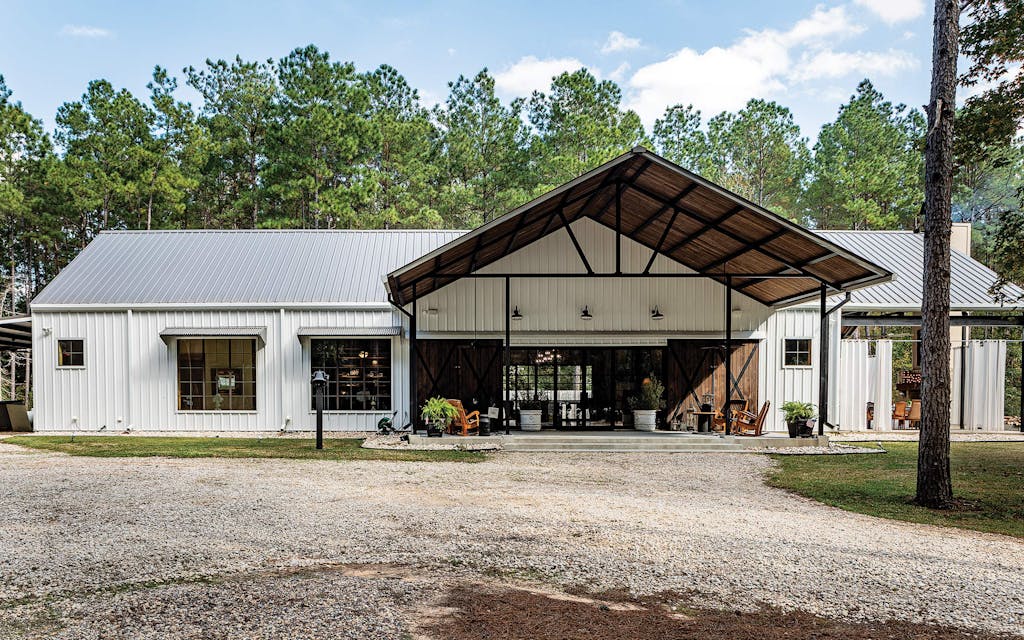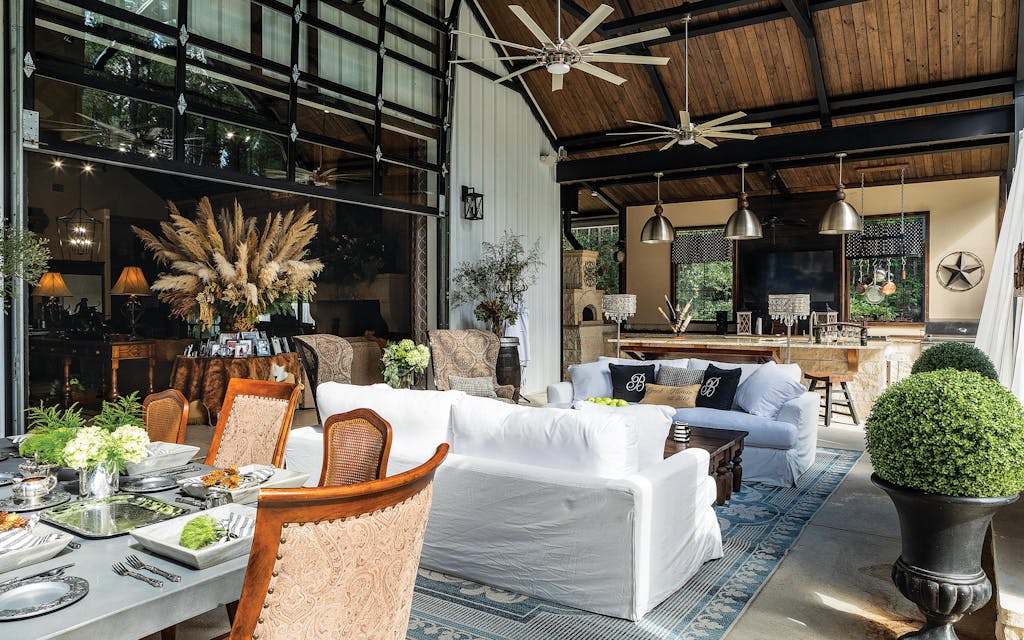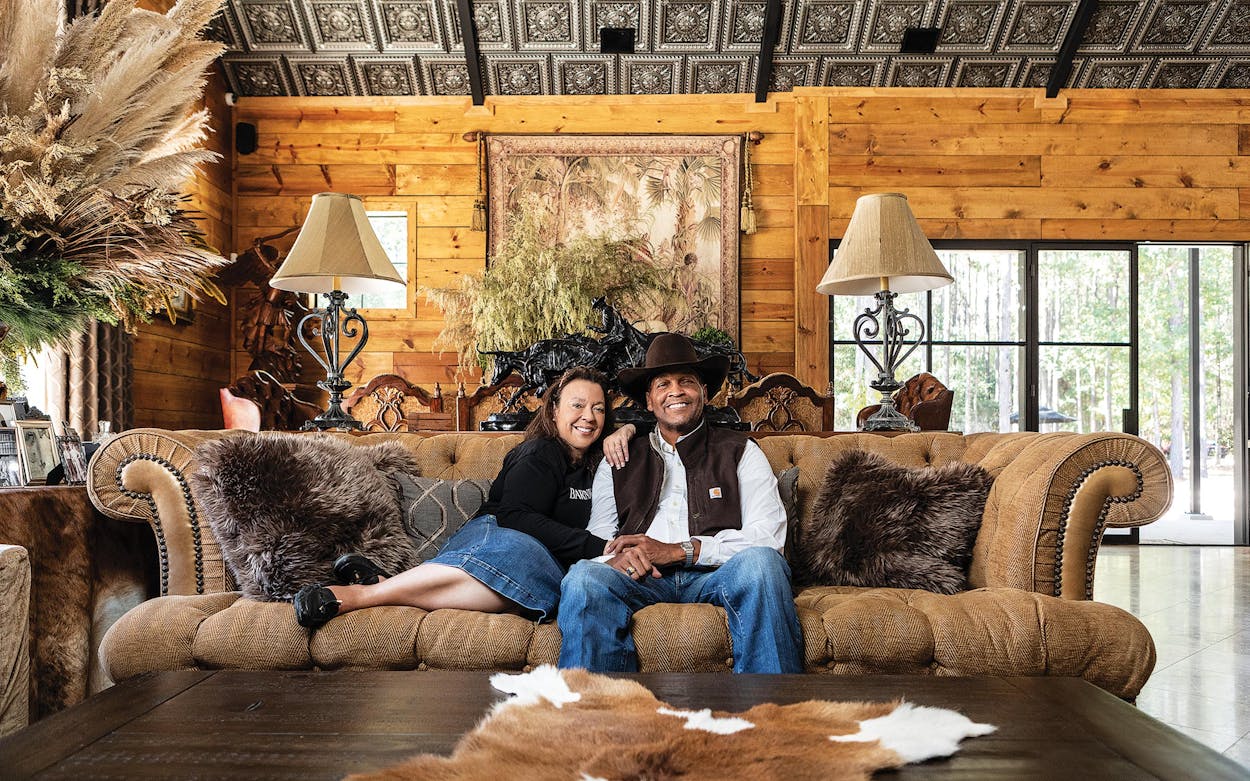Surely this can’t be the place. As I turn left off a gravel road somewhere around Cleveland, north of Houston, I drive through a dense grove of spindly pine trees. I’m convinced my GPS must be on the fritz, hurtling me toward a thicket of the nearby Sam Houston National Forest instead of my destination. I gingerly proceed a bit farther. An enchanting white barn resembling the sort of sleek modern farmhouse one might see on HGTV suddenly materializes, as if magically summoned there.
Stacee Lynn Bell waits for me on the concrete front porch, which has a stately gabled roof. Dubbed the Creek House, the home serves as a stylish and comfortable abode for Stacee Lynn and her husband, Oliver Bell, as well as a spacious temporary headquarters for the couple’s business and an alfresco party palace—flowing white curtains ensconce a vast side patio that includes a fireplace, outdoor kitchen (complete with a pizza oven), and living and dining areas. I walk up to meet her by the pair of handsome wood-and-steel sliding front doors. “I say that my porch is my foyer,” Bell says, gesturing to four chestnut-colored rocking chairs, each engraved with the name of one of the couple’s four grown children. I’m about to enter my first barndominium.
A low-maintenance, energy-efficient structure, the barndominium—a portmanteau of “barn” and “condominium”—has emerged as a residential design trend over the past couple of years. Barndominiums, which are typically freestanding single-family structures, can often be built more quickly and cheaply than traditional homes because they’re usually made from cost-effective materials, including sheet metal, concrete, and steel. They aren’t cropping up just in rural areas either. Barndo-friendly communities are planned for the Austin area as well as for Conroe and Willis, both near Houston; they will allow for this kind of structure, along with farmhouses and traditional homes.
With soaring roofs and open floor plans (the load-bearing walls are all exterior unless the structure has more than one story), barndominiums look sharp despite their modest components. But steel construction has aesthetic limitations (touches such as crown molding and bay windows, for example, are expensive to build out), and homeowners must be vigilant about protecting the rust-prone steel exterior from moisture.

An affable 57-year-old designer and contractor, Stacee Lynn erected a small, 1,500-square-foot barndominium in Montgomery County, close to Cleveland, in 2017; two years later, with elbow grease and hardware-store hacks, the Bells built their 5,200-square-foot barndo using her own design and floor plan. Stacee Lynn documented the construction on social media accounts, which attracted followers who wanted to know more about the Creek House. In 2020 the couple launched a design and consulting company, Our Barndominium Life, which includes services such as drawing up plans, making contractor and builder referrals, and consulting on finish-out selections. “All of a sudden, the phones started ringing, and I couldn’t handle all the work,” Stacee Lynn says.
When I meet with the couple in September, they say they’re working on more than a hundred residential and commercial projects across the country; about 40 percent of those are in Texas. (Like others in the industry, the Bells are dealing with supply-chain issues on everything from steel to appliances; Stacee Lynn expects the backlog to ease by midyear.) The vast majority of their projects involve brand-new homes, though in rare instances the Bells can retrofit barndominiums onto preexisting steel structures. Stacee Lynn, who often sports a black T-shirt emblazoned with her nickname, “The Barndo Lady,” along with a double string of pearls, draws up custom designs for clients as well as ready-to-go plans, which start at $1,395 for a standard barndo.
She also helms the business’s Instagram and TikTok accounts—where about 92,700 and 402,000 followers, respectively, watch her extol the virtues of steel frames and of installing glass garage doors to connect indoor and outdoor spaces. Stacee Lynn tells me, “I feel like the jet plane has taken off and I’m holding on to the rope as I’m trying to catch up to get inside.” (Oliver, who had a human-resources consulting firm before going into the barndominium business, describes his role as “logistics” and “the wind beneath” Stacee Lynn’s wings.)
The Bells aren’t the only designers specializing in barndos. Two such notable firms include Oregon’s DC Builders, known for its distinctive timber aesthetic, and the Oklahoma-based Greg James Designs, started by a former Gulf Coast resident and boat builder. What sets the Bells apart is how they design with experiences in mind—say, a karaoke space or a sprawling living area for game night—rather than typical room layouts. They want to change the perception of steel; although it’s frequently used in dreary, lifeless commercial buildings, in their hands it becomes the pliable backbone of welcoming digs. “Steel, up until now, it’s been very industrial—dare I say cold,” Stacee Lynn says. “But we’ve taken that cold industrial material, and we’re making it sing. We’re saying, ‘Don’t cover it up. Show off that steel.’ ” Oliver, a willowy man whose stature is accentuated by the towering black Stetson on his head, nods. What Stacee Lynn has done “is almost like the old shows they had on MTV, Cribs or Pimp My Ride,” he says.
Their barndos have included everything from pickleball courts, bowling alleys, and golf simulators to rock walls and billiard rooms. It’s clear that they get a kick out of unusual flourishes: during my tour of the Creek House, the couple usher me into the main downstairs bathroom, which features a massive bookshelf lined with family photos. Stacee Lynn, grinning, pushes on the shelf’s middle panel, which opens up to reveal a walk-in closet.
The couple are among few, if any, Black designers and consultants in Texas working in the growing barndominium field, which has also traditionally been male-dominated. “It’s not only that there are not a lot of women in steel. But women of color? I don’t know any,” Stacee Lynn says.


Barndominiums have their origins in “shouses,” (a mash-up of “shop” and “house”), workshops with residences attached. Shouses are typically found in rural areas; their roots have been traced to the Middle Ages. One of the first appearances of the term “barndominium” was in a 1989 New York Times interview with real estate developer and equestrian Karl Nilsen, who used it to describe his residential lots that included stables. While some interest trickled in from fellow horse enthusiasts, Nilsen’s barndominiums hardly boomed in the soft housing market at the time, and the design didn’t take off in construction until decades later—when two Texans on HGTV introduced the concept to the masses.
On a 2016 episode of the smash home-improvement show Fixer Upper, a couple called on the Waco-based celebrity renovators Chip and Joanna Gaines to help them find their perfect place. The young family’s stipulations: their home had to have character and ample space for entertaining. The spot the Gaineses found, a weary barn outside nearby Lacy Lakeview, was a stretch for even the construction gurus, who are hardly strangers to sprucing up dilapidated dwellings. “I’m not even sure it qualifies as a house,” Chip Gaines muttered as the couple drove up to the property.
The Gaineses gutted the interior and installed sliding doors, several bedrooms, and a grand entryway that prominently displayed a seventeen-foot-long banquet table. The property transformed into a chic, high-ceilinged structure that felt intimate rather than industrial. Chip and Joanna called it a barndominium on the show, which revealed to potential homeowners that barns had much more potential than merely housing horses and hay.
That revelation has come in handy lately, as a dearth of inventory and supply-chain snafus have factored into skyrocketing building costs. The ripple effects of the coronavirus pandemic have also impacted the sorts of homes, and the acreage, that many buyers are seeking—it’s almost the opposite of the recent “tiny house” phenomenon. “There’s a trend out there—we call it the ‘elbow room’ movement,” Oliver says. “You’ve got people in the city moving to the outskirts of the city; people on the outskirts are moving a little further out. A lot of our clients are looking for one or two acres so they can spread out. In some cases, they’re looking for two hundred.”
That’s how the Bells ended up in Montgomery County five years ago. A Louisiana native who moved to the Bayou City to attend the University of Houston, Stacee Lynn met Oliver, an army brat who’d spent two years of high school in Texas, when they worked as volunteers for Sylvester Turner’s first mayoral run, in 1991. Stacee Lynn had read the Times article that mentioned Nilsen; the idea stuck with her. When they eventually secured their fourteen-acre lot to build the Creek House, Stacee Lynn—who had learned about construction after designing the couple’s former Austin home and remodeling another past residence in Horseshoe Bay—drafted up plans for their barndominium.
But finding the right contractor proved challenging. “At the time, I was struggling to find a builder, and my husband said, ‘I don’t know why you just don’t build this yourself; you know all of this,’ ” Stacee Lynn remembers. “The next day I became the general contractor and began building our barndo.”

Among the Bells’ clients are 40-year-old homemaker Candice Morris, her husband, 41-year-old realtor Jeff Morris, and their seven children (they also have turkeys, chickens, and Nigerian dwarf goats as well as a milk cow, a bull, and a Kunekune pig—a breed that originated in New Zealand). The family lives in Magnolia, in Montgomery County, but plans to move to the town of Montgomery, where they are building their dream barndo, with a karaoke stage and abundant space for dining. While researching barndominiums, Candice found the Bells’ website and emailed Stacee Lynn, who swiftly drew up a blueprint. “It took her, like, ten minutes,” Candice says. “She really has a gift for creating individual spaces.”
The project—dubbed “Cindy Lou’s,” after Jeff’s late mother—has ballooned into a three-story, eight-thousand-square-foot slate-gray edifice held up by interior steel beams painted with a black sheen. It comes replete with a tack room (for storing saddles and other equestrian gear), a generous pantry, a penthouse playroom, and a great hall.
In addition to designing homes, Stacee Lynn works as an interior decorator, dressing up the houses she helps create and making them feel cozy despite the steel and other industrial materials. Walking me through the kitchen of the Creek House, she points out where a new haul of consignment-furniture finds will live alongside an antique French buffet, a Belgian tapestry, a tufted Italian fresco painting, and a coffee table from Restoration Hardware. “I’m mixing so many different styles: modern, contemporary, traditional Mediterranean or European,” Stacee Lynn says.
After the house tour, she takes me to one of her favorite consignment stores, French Courtyard, in the Woodlands, which teems with oversized wooden cheese boards and regal armoires. She eagerly beelines toward a large glass candleholder that she recently purchased. (“I’m a candle girl,” she says.) It apparently belonged to ZZ Top bassist Dusty Hill, who died last summer—some of his estate ended up at the store. Stacee Lynn moseys over to an ottoman, running her hands over the fabric, then admires a wooden bench that she envisions as part of a mudroom or bedroom. Eventually she settles on a black-and-white-checkered throw pillow fashioned with an embroidered bee. “Oh, it’s beautiful,” she gushes. “I know exactly where it’s going to go.” Later, she texts me a photo of the pillow’s new home: her own couch.
Stacey Lynn and Oliver are considering adding a “modern-rustic” home accessories line to their business and are working on a new website detailing the “barndo hacks” they’ve culled over the years. They’re even planning to expand their business into Canada and take on clients there.
The couple is also thinking of future generations who might take the trend in new, ambitious directions. Their team of eighteen employees is notably young and diverse, and many of them dream of designing and building their own barndominiums down the line, the Bells tell me. “People do what they’re exposed to,” Oliver says. “The construction and design business has not necessarily [had] a lot of diversity, but we’re trying to help with that and encourage people. Stacee reminds folks that we’re doing something new and exciting. We’d like to see people go as far as they can and maybe create an opportunity for themselves.”
Paula Mejía is a writer and editor from Houston.
This article originally appeared in the January 2022 issue of Texas Monthly with the headline “Barn Sweet Barn.” Subscribe today.
- More About:
- Style & Design
- Architecture
- Chip & Joanna Gaines
- Waco
- Montgomery









